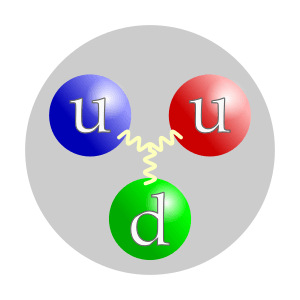Up quark facts for kids
Up quarks are tiny, tiny particles that are some of the most basic building blocks of everything around us. They are so small that scientists believe they can't be broken down into anything smaller. Up quarks are a type of particle called a quark, and they help make up bigger particles like protons, which are found in the center of every atom.
Contents
What Are Up Quarks?
Up quarks are a type of elementary particle. This means they are thought to be fundamental, with no smaller parts inside them. They are the lightest of the six different types, or flavors, of quarks.
Key Features of Up Quarks
Up quarks have a special electric charge of +2/3. This is different from the charge of a proton, which is +1. Like all particles called fermions, up quarks have a property called spin of 1/2. Think of spin as a tiny internal rotation.
Up quarks are affected by all four of the basic forces in the universe:
- Gravity: The force that pulls things together.
- Strong force: The strongest force, which holds quarks together inside protons and neutrons.
- Weak force: This force is involved in how particles change from one type to another.
- Electromagnetism: The force that creates electricity and magnetism.
Building Blocks of Matter
Up quarks are super important because they combine with other quarks to make up bigger particles.
Making Protons and Neutrons
- Protons: A proton has a total charge of +1. It is made of two up quarks (each with a charge of +2/3) and one down quark (which has a charge of -1/3). If you add up their charges (2/3 + 2/3 - 1/3), you get +1.
- Neutrons: A neutron has no charge, meaning its total charge is 0. It is made of one up quark (charge +2/3) and two down quarks (each charge -1/3). If you add up their charges (2/3 - 1/3 - 1/3), you get 0.
These protons and neutrons then form the center, or nucleus, of every atom.
Other Particles
Up quarks can also combine to create other more complex particles. For example, they can be part of particles called pions. Pions are involved in the strong force that holds atomic nuclei together.
See also
 In Spanish: Cuark arriba para niños
In Spanish: Cuark arriba para niños


